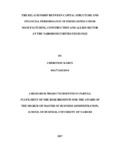| dc.description.abstract | Capital structure plays a remarkable function in firm’s financial performance give that it is utilized efficiently and in an effective manner at its optimal level. However, the question of what constitute an optimal financing structure remains unanswered and a controversial issue in corporate finance. The aim of this research is to determine the relationship between capital structure and financial performance of companies listed under Manufacturing, Construction and Allied Sector at the Nairobi Securities Exchange. The Modigliani and Miller, Pecking Order and the Trade-off theories formed the theoretical foundation of the study. This research used a descriptive study design and targeted fifteen listed firms in the Manufacturing, Construction and Allied sector at the NSE as at 31st December 2016. This study employed secondary data, which was collected using a data collection sheet for the period 2012 to 2016. To analyze data, the research used descriptive statistics and regression analysis using the Statistical Package for Social Sciences. The study found that the ratio of debt to equity had an insignificant effect on return on assets while liquidity had a positive and significant effect on return on assets ratio. Further, the firm size and growth had an insignificant and positive relation with the return on assets of the listed manufacturing, construction and allied firms. The study concluded that it is only liquidity, which affects the financial performance of the listed man manufacturing, construction and allied firms while capital structure, firm size and growth have no significant effect on financial performance of manufacturing, construction and allied firms quoted at the NSE. The study recommended that the management of construction and manufacturing firms should institute proper liquidity management techniques to ensure they hold optimal liquidity levels. Additionally, the firms should ensure that they hold optimal levels of debt since high debt may affect other goals of the firm. | en_US |



